Abstract
Against the backdrop of multifaceted strategies to combat climate change, understanding soil erosion’s role in carbon cycling is critical due to terrestrial carbon pool vulnerability. This study integrates bibliometric methods with visualization tools (CiteSpace, VOSviewer) to analyze 3880 Web of Science core publications (1994–2024, inclusive), constructing knowledge graphs and forecasting trends. The results show exponential publication growth, shifting from slow development (1994–2011) to rapid expansion (2012–2024), aligning with international climate policy milestones. The Chinese Academy of Sciences led productivity (519 articles), while the US demonstrated major influence (H-index 117; 52,297 citations), creating a China–US bipolar research pattern. It was also found that Dutch journals dominate this research field. A keyword analysis revealed a shift from erosion-driven carbon transport to ecosystem service assessments. Emerging hotspots include microbial community regulation, climate–erosion feedback, and model–policy integration, though developing country collaboration remains limited. Future research should prioritize isotope tracing, multiscale modeling, and studies in ecologically vulnerable regions to enhance global soil carbon management. This study provides a novel analytical framework and forward-looking perspective for the soil erosion research on soil carbon cycling, serving as an extension of climate change mitigation strategies.
1. Introduction
Greenhouse gas emissions have led to global climate change and have triggered a series of environmental disasters (such as recent heatwaves in Europe and the United States that sparked large-scale wildfires and this year’s 30 °C temperature in Finland’s Arctic Circle—breaking the region’s 100-year meteorological record and threatening the Arctic ecosystem), posing threats to human survival and development. Accordingly, addressing global climate change has become essential to the shared future of humankind; the need to achieve carbon neutrality has emerged as a global consensus [1,2]. Soil, which is a carbon pool in the terrestrial ecosystem, harbors about 2500 Pg of carbon (1550 Pg of soil organic carbon (SOC) and 950 Pg of soil inorganic carbon (SIC)), and even minor changes in this balance (between SOC and SIC) can result in significant carbon emissions [3,4,5]. However, the soil carbon pool is not stable, and carbon cycling within this pool is influenced by various factors (such as soil erosion, climate change, and land use alterations) [6,7], among which soil erosion plays a critical role. Moreover, the detachment–transport–deposition process of soil erosion accelerates the lateral transfer of ecosystem carbon, significantly altering the spatial distribution of SOC [8,9,10]. The impact of soil erosion on the carbon budget balance and soil carbon cycling has long been a global research hotspot, especially in the context of global climate change and the dual carbon (carbon peak and carbon neutrality) goals. In this field, the source/sink effect within soil carbon cycling has become a focal point of debate, with relevant research offering important guidance for maintaining the normal functioning of the global carbon cycling system [11,12,13].
Therefore, outlining research findings regarding the impact of soil erosion on soil carbon cycling and constructing a research framework in this field will provide insight and references that will be valuable to future studies. To date, the impact of soil erosion on soil carbon cycling has been reviewed from multiple perspectives. For instance, the effects of soil erosion on carbon cycling have been considered based on geochemical-cycling-induced or orogenesis-induced changes in soil erosion patterns or through the use of experimental models [14,15,16]. Retrospective studies have investigated the impact of hydraulic erosion on SOC migration and deposition processes, as well as on carbon emissions [17,18,19]. Moreover, the effects of hydraulic erosion on pyrolyzed soil carbon have been examined [20].
Although there is extensive literature describing the impact of soil erosion on soil carbon cycling that spans a wide range of subjects, few studies have employed knowledge mapping to provide an in-depth analysis of the research hotspots and future research directions in this field. Bibliometrics is a quantitative method used to describe and analyze the dynamics and progress of a specific discipline or research area. This method utilizes relevant software (such as CiteSpace, VOSviewer) to generate clear and concise knowledge graphs that present literature analysis results in a visualized manner, allowing for the effective identification of the developmental pattern of a given research area [21,22]. Knowledge graphs, which depict the development process and structural relationships of knowledge, serve as both visual knowledge representations and serialized knowledge pedigrees. These graphs reveal complex relationships such as networks, structures, interactions, intersections, evolutions, and derivations among knowledge units or groups [23]. Therefore, the present study employed bibliometric methods and visualization analysis tools (CiteSpace and VOSviewer [24,25]). We selected 1994–2024 as the study period, as it fully covers key stages in soil carbon research. Firstly, in 1994, UNFCCC entered into force, which spurred interdisciplinary research [26,27,28,29]. Studies like the 2006 Global Carbon Project, which released soil carbon pool data and applied techniques such as carbon tracing and erosion modeling [30,31,32], improved research conditions by advancing soil erosion–soil carbon sink studies. Then, the NDC mechanism of the 2015 Paris Agreement further drove research. In 2019, the IPCC SRCCL report first established soil erosion as a major driver of terrestrial carbon loss. Finally, in 2024, COP29 assessed NDC implementation, therefore forming a complete policy cycle (Figure 1). Our selection shows methodology evolution from qualitative to quantitative and captures the dynamic interaction between climate policy and scientific research.
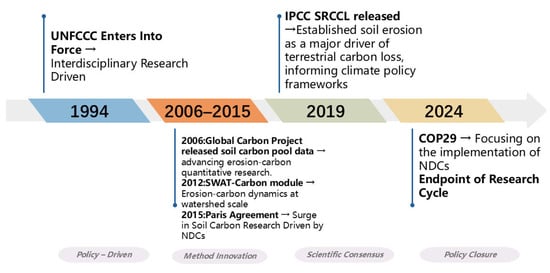
Figure 1.
Climate policy and soil erosion–soil carbon research synergistic evolution timeline (1994–2024).
With this time frame established, the aim of the study was to systematically summarize and synthesize the development, communication, hotspots, and outcomes of global studies that have investigated the impact of soil erosion on soil carbon cycling over the past 31 years. Specifically, this study employed knowledge mapping analysis tools using the subject terms “soil erosion” and “carbon” to conduct a network analysis of author countries, authors, institutions, and disciplines. The results of this analysis were then used to visualize research hotspots and keyword co-occurrence networks that reflect the latest research advancements pertaining to the impact of soil erosion on soil carbon cycling.
2. Materials and Methods
2.1. Data Selection and Processing
The data for this study were sourced from the Clarivate (Philadelphia, PA, USA) Web of Science (WoS) Core Collection database (2025). Comprehensive and accurate retrieval was ensured by selecting the Science Citation Index Expanded and Social Sciences Citation Index. The search strategy employed was topic search TS = (“soil erosion”) AND TS = (“carbon*”), covering the period from 1 January 1994 to 31 December 2024; the document types were limited to articles or review articles, with the language restricted to English. On 30 March 2025, we conducted the aforementioned search (all data collection was based on complete calendar years to ensure consistency in comparative analyses), and this search yielded a total of 4159 articles. Drawing on past experience [33,34], the collected literature was processed in the following sequence. First, we defined the study’s focus as “the impact of soil erosion on carbon cycling under climate change,” covering the underlying mechanisms and research trends related to how climate change influences soil erosion processes and how these processes in turn affect the transport of soil organic carbon, carbon sink functions, and ecosystem carbon balance. Literature was limited to articles and review articles to ensure robust metric data and maintain the core academic focus of the study. While conference proceedings offer valuable insights, we focused on journal articles for standardized citation metrics, peer-reviewed rigor, and to avoid duplication following Bibliometric–SLR guidelines [35]. Following this, we went through each document: those that did not fit the research theme or meet the search criteria were excluded; documents with the same concepts were consolidated; then, terms with low frequency (fewer than three occurrences) were removed. Ultimately, a sample of 3880 articles was obtained.
2.2. Analytical Methods
Commonly used tools for the visual analysis of the literature include CiteSpace (https://citespace.podia.com/ (accessed on 11 March 2025)), VOSviewer (https://www.vosviewer.com/download (accessed on 12 March 2025)), and Gephi (https://gephi.org/users/download/ (accessed on 12 March 2025)), among which CiteSpace is the most influential. This tool offers a wealth of features for identifying knowledge networks, including the analysis of data and the expression of time series in terms of citations, authors, sources, countries, and keywords [36,37]. VOSviewer is a bibliometric visualization software that was introduced in 2010 [38]. This software utilizes a probabilistic approach for data normalization and provides various visualization views for keywords, institutions, and co-authorships, including network visualization, overlay visualization, and density visualization, while enabling easy mapping and providing aesthetically pleasing graphics [39].
After gathering the original literature data, both qualitative and quantitative analyses were conducted using CiteSpace 6.4.R1 (64-bit) (Chaomei Chen, Drexel University, Philadelphia, PA, USA) and VOSviewer 1.6.19 (Leiden University’s Centre for Science and Technology Studies [CWTS], Leiden, The Netherlands) in conjunction with OriginPro 2022 (OriginLab Corporation, Northampton, MA, USA) and the R package bibliometrix 4.1.4 (University of Naples Federico II, Naples, Italy). Within CiteSpace, the timeline spanned from 1994 to 2024 (inclusive) with one-year time slices, and connection strength was calculated using the cosine algorithm, which, with advantages like computational simplicity and precise data feature capture, facilitates analyzing various relationships in bibliometric data [40]. To avoid a cluttered visualization, the pruning strategy was set to “Pathfinding,” “Pruning Sliced Networks,” and “Pruning the Merged Network.” In VOSviewer, the counting method was set to “Full Counting,” and the association strength algorithm was employed to perform a bibliometric network analysis of the authors. Furthermore, data were exported from VOSviewer into Pajek software (version 5.17; developed by Vladimir Batagelj and Andrej Mrvar, University of Ljubljana, Faculty of Social Sciences, Ljubljana, Slovenia). After analysis in Pajek, the clustering graph was adjusted as needed to obtain a unified color clustering graph for later analysis.
Based on the above description and the data collection procedures in 2.1 Data selection and processing, we developed a research design flowchart (Figure 2) to introduce our research process more clearly.
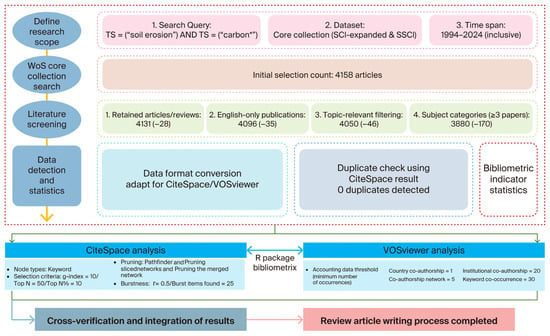
Figure 2.
Flowchart of experimental design based on the WoS database (“*” is a wildcard in WoS denoting any character sequence).
3. Results
3.1. Publication Trend Analysis
The number of articles published in an academic field annually can represent the trend of attention the field has received in recent years [41]. The number of articles published on the impact of soil erosion on soil carbon cycling is shown in Figure 3. From 1 January 1994 to 31 December 2024, the number of published articles pertinent to soil erosion and soil carbon cycling research and the sum of times cited (SOTC) generally exhibit exponential growth trends. According to Price’s law, this research field is in a phase of rapid development, with research directions and new technologies emerging continuously [42]. Overall, this research field has moved through two stages: a slow development stage (1994–2011) and a rapid growth stage (2012–2024). During the slow development stage, the number of articles published on the impact of soil erosion on soil carbon cycling grew slowly, with an average annual increase of five articles. During 2012–2023, a rapid growth stage was entered. During this stage, there was an average annual increase of 20 articles compared to the previous year, with 2012, 2016, and 2018 each seeing increases of more than 40 articles.
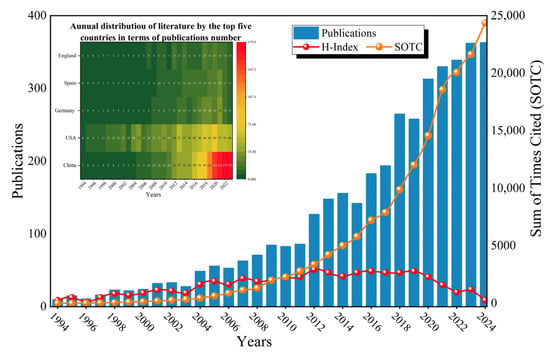
Figure 3.
Global trends in publications, total citations, and H-indexes for research on the effects of soil erosion on soil carbon cycling over the past 31 years.
The H-index is a hybrid quantitative indicator introduced in 2005 by Jorge E. Hirsch to evaluate the volume of academic output and the quality of the researchers involved. This index has now been rapidly extended to assess research by specific teams, institutions, countries/regions, and other scientific communities, as well as for academic journal evaluations [43,44]. During the slow development stage, the average H-index was relatively low (H = 25) but showed an increasing trend, indicating continuous improvement in publication impact during this period. In contrast, the rapid growth stage had a relatively higher average H-index (H = 40) that later showed a declining and unstable trend, suggesting that the impact of publications became unstable and research was nearing saturation in the latter period. Additionally, the top five countries in terms of the number of published articles were China, the United States, Germany, Spain, and the United Kingdom, with China showing a significant increase in publications, especially between 2018 and 2024; this trend likely stems from both a growing research focus on soil erosion and carbon cycling, as well as structural factors such as expanded research capacity and national investment in environmental science.
3.2. Analysis of Scientific Collaboration Networks
3.2.1. Analysis of Author Co-Authorship Networks
An analysis of co-authorship networks enabled us to identify the main researchers who are investigating the impact of soil erosion on soil carbon cycling and their close collaborative relationships [45]. Using VOSviewer software, we overlaid and visualized the co-authorship networks of authors who have published more than five articles in the field, leading to six clusters (Figure 4a). In the cluster view, authors of the same color belong to co-authorship networks in the same cluster, the sizes of the dots represent the numbers of published articles, and the lines show the collaborative links between authors. Overall, researchers investigating the impact of soil erosion on soil carbon cycling display distinct network characteristics, with strong collaborative relationships within smaller scopes. As shown in Figure 4b, the largest network belongs to “Lal, Rattan,” an internationally renowned researcher of soil erosion and management from the United States, followed by “Li, Zhongwu” from China and “Van Oost, Kristof” from Belgium. To evaluate their long-term research impact, we analyzed both the thematic evolution in Figure 5a and the quantitative metrics in Table 1. As shown in Figure 5a, “Lal, Rattan” has conducted long-term research with a stable number of published articles in this field, with persistent focus on core themes (soil organic carbon and carbon sequestration) that underpin enduring influence while increasingly integrating climate change dimensions. Meanwhile, “Li, Zhongwu” has undertaken a large amount of research since 2015, with the research interest in soil erosion–soil organic carbon gradually increasing and citation relevance rising accordingly (Table 1). Research by “Van Oost, Kristof” was mainly conducted after 2005 and has fluctuated considerably among topics, mirroring transient thematic contributions (such as soil degradation and soil erosion peaks) visible in their interest dynamics.
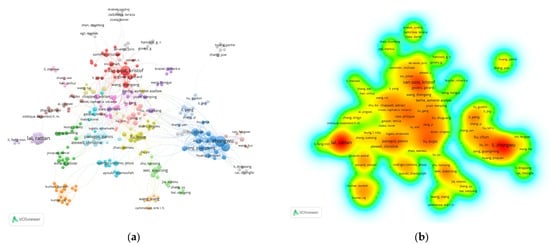
Figure 4.
(a) A network visualization map for the co-authorship analysis; (b) density visualization produced based on the number of articles published by the authors.
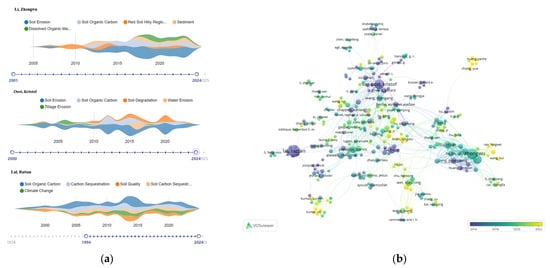
Figure 5.
(a) Author research interest statistics (1994–2024), available online at https://www.aminer.cn/(accessed on 17 May 2025); (b) an overlay visualization map of author co-authorship analysis.

Table 1.
The 10 most productive authors publishing research on the effects of soil erosion on soil carbon cycling.
The top 10 authors in terms of the number of published articles are shown in Table 1. Among these, the top three are “Lal, Rattan” (74 articles), “Li, Zhongwu” (56 articles), and “Van Oost, Kristof” (50 articles). Notably, “Lal, Rattan” (total link strength (TLS) = 23) and “Van Oost, Kristof” (TLS = 108) have lower TLS values despite having published a significant number of articles and starting research in this field earlier than others (Figure 5b), indicating less collaboration with other authors.
For this study, a group of authors was only considered to be the core group of authors when the total number of articles published by the group exceeded half of the total articles published in the field. According to Price’s law [46], the formula for calculating the minimum number of articles published by a core author in an area is as follows:
where nmax is the number of articles published by the most productive author within the field. With a total of 15,065 effective authors and the highest number of published articles in this field being 74 (Table 1), m was calculated to be 6.44. Therefore, authors who have published seven or more articles in this field were identified as core authors. A total of 139 core authors who have published 1615 articles in total were identified, accounting for 41.62% of the total number of effective papers. This finding indicates that a core group of authors has not yet formed.
3.2.2. Analysis of Institutional Co-Authorship Networks
VOSviewer software was employed to conduct a statistical and visual analysis of the source institutions of WOS publications. The analysis identified a total of 452 institutions; among these, 63 were selected based on a minimum publication threshold of 20 articles. A network analysis of institutions that published papers pertaining to the impact of soil erosion on soil carbon cycling from 1994 to 2024 was then conducted (Figure 6a). Close collaborations were observed among the Chinese Academy of Sciences, the University of Chinese Academy of Sciences, and Northwest A&F University (China), with other international research institutions also demonstrating close cooperation. Notably, the number of articles published by Chinese institutions primarily increased after 2020 (Figure 6b).
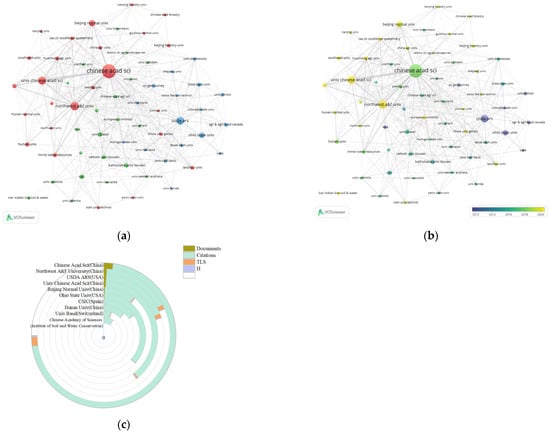
Figure 6.
(a) A network visualization map of country co-authorship analysis; (b) an overlay visualization of country co-authorship analysis; (c) proportion of comprehensive strength for the top 10 high-productivity institutions.
As shown in Table 2, the top 10 publishing institutions in terms of the number of published articles included six universities and four research institutes. The Chinese Academy of Sciences published the most publications (475 publications), significantly surpassing the publishing institution that came in second place, Northwest A&F University. Based on these findings, the Chinese Academy of Sciences was the most representative institution for research on the impact of soil erosion on soil carbon cycling. In terms of publication quality, the Chinese Academy of Sciences ranked first (H = 78), followed by the United States Department of Agriculture—Agricultural Research Service (USDA-ARS; H = 64). As shown in Figure 6c, which illustrates the comprehensive strengths of the above-mentioned top 10 publishing institutions, the Chinese Academy of Sciences was found to be the most prominent research institution in this field.

Table 2.
Ranking of research institutions by number of papers.
3.2.3. Analysis of Country/Region Co-Authorship Networks
Research on the impact of soil erosion on soil carbon cycling has been conducted by researchers in 115 countries/regions, primarily concentrated in Asia, North America, and Europe (Figure 7a). Table 3 lists the top 10 countries in terms of publication productivity in this field. Overall, China and the United States rank first and second, with 1439 and 946 articles published, respectively, significantly outpacing other countries.
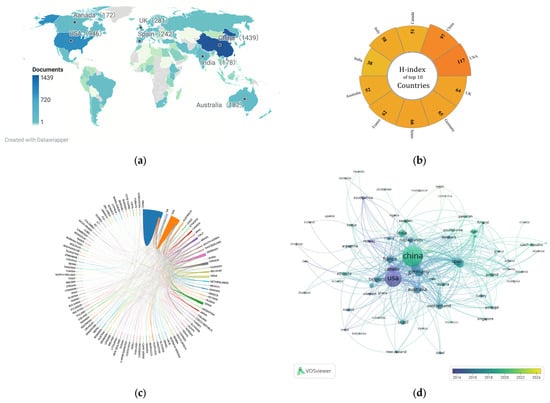
Figure 7.
(a) Geographic distribution map based on the total publications from researchers in different countries/regions; (b) distribution map of the top 10 countries with H-index values; (c) a cross-country/region collaborations visualization map—here, the thickness of the line between countries reflects the frequency of cooperative research; (d) overlay visualization of the country co-authorship analysis.

Table 3.
Ranking of countries by number of publications.
Figure 7b displays the top 10 countries by H-index, a metric reflecting academic visibility and cumulative impact. The United States dominates both in H-index (117) and total citations (52,297), reflecting its substantial footprint in this research domain. However, these metrics should be interpreted in context: the H-index captures sustained academic visibility that may be affected by factors such as publication output, field-specific citation norms, and institutional collaboration networks, not just scientific merit. As shown in Figure 7c, productive countries/regions closely collaborate with each other. China, which had the highest publication productivity, collaborates closely with the United States. However, there is less cooperation among other countries, especially among developing countries. Figure 7d showcases research progress and network relationships among 30 countries/regions. In this figure, colors closer to cool tones indicate earlier research commencement, while denser node connections indicate stronger linkage. The top three countries/regions in terms of TLS are China (TLS = 501), the United States (TLS = 490), and Germany (TLS = 300). Additionally, the United States and European countries began research in this field earlier than other countries.
3.2.4. Analysis of Journal Influence in the Research Field
To comprehensively assess the influence of journals in the field of soil erosion impacts on carbon cycling under climate change, we compiled data on the influence of the top 10 journals in terms of publication volume (Table 4). The total citation frequency showed a large range, with the highest value being 1718 (Science of the Total Environment) and the lowest value being 190 (Journal of Soils and Sediments), indicating significant differences in the overall influence of these journals. Figure 8 also shows that journals from different countries have varying impacts on the interdisciplinary field of soil erosion and carbon cycling. Journals from The Netherlands (Science of the Total Environment and CATENA) and the UK (Land Degradation & Development) demonstrate long-term influence in this field. Science of the Total Environment ranks highest in Table 4 in terms of impact factor (IF = 50.53) and total citation count (1718), indicating its broad appeal in interdisciplinary fields. Additionally, it can be seen that these influential journals are all from Europe. In summary, there are significant differences in journal influence and regional contributions to soil erosion carbon cycle research.

Table 4.
Ranking of journals by number of publications.
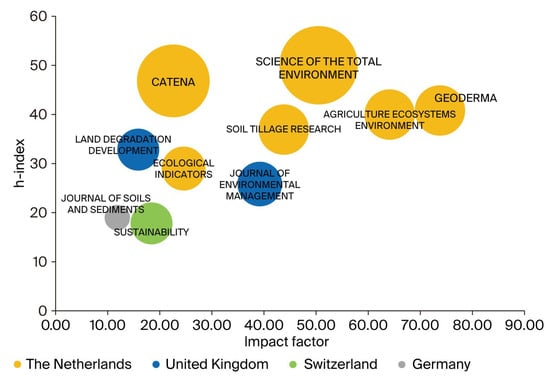
Figure 8.
Bubble chart of journals impact factor vs. H-index, with bubble size as publication count, grouped by country.
3.3. Research Themes and Development Trends
Keywords can reflect the research themes, content, theories, methods, and perspectives of a paper [47]. By analyzing keywords to outline the content in the literature, one can comprehensively and scientifically understand research hotspots and frontier dynamics [48]. In this study, keyword co-occurrence, clustering, and popularity analysis were analyzed using VOSviewer, while the timeline distribution and keyword trends were analyzed using CiteSpace and the R package bibliometrix.
3.3.1. Keyword Co-Occurrence Analysis
Using the visualization software VOSviewer, a keyword co-occurrence network analysis of keywords appearing from 1994 to 2024 was conducted after the synonyms were merged. This study encompassed 194 core terms. The high-frequency keywords that appeared more than 30 times are listed in Table 4, of which “soil erosion” (1856 occurrences) was the most frequently occurring. As shown in Figure 9a, five major keyword clusters representing five themes were formed. In this figure, a larger circle node indicates increased frequency of the keyword, indicating that it is more representative as a research hotspot in this field. The line connections in this figure represent the strength of association, with thicker lines indicating more frequent co-occurrence in the same documents. Node colors represent different clusters, i.e., research themes. Density visualization (Figure 9b) can be used to identify research hotspots, with darker areas indicating higher intensity of interest and attention within this field. As shown in Figure 9b and Table 5, high-frequency keywords such as “soil organic carbon,” “organic matter,” “land-use change,” “nitrogen,” and “runoff” are representative terms in studies on the relationship between soil erosion and carbon. Furthermore, the different numbers of connections between each keyword cluster suggest the existence of overlapping relationships among research themes, aligning with the interdisciplinary nature of this research field.
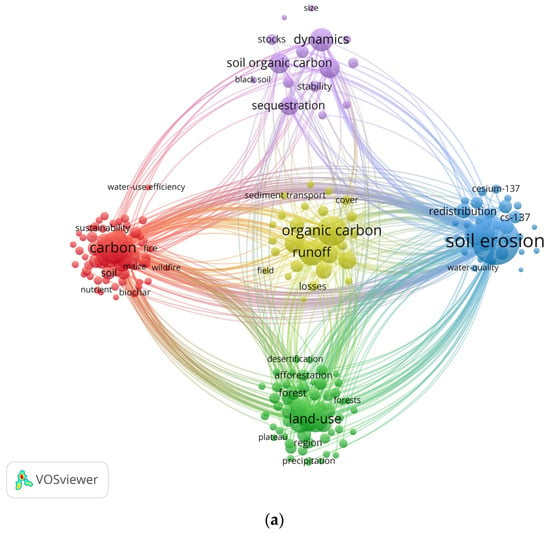
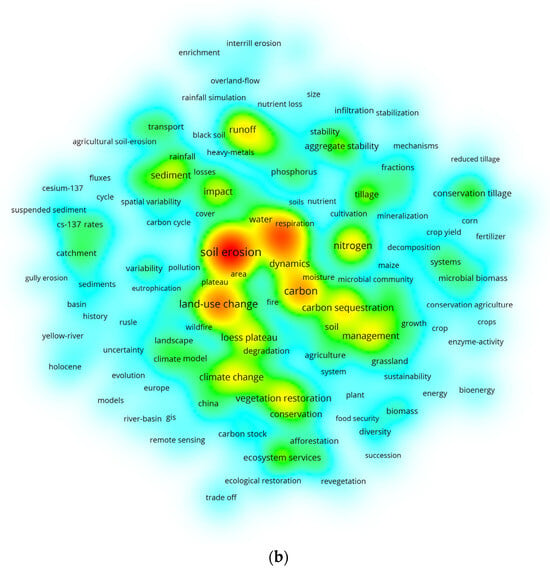
Figure 9.
(a) Keyword co-occurrence network after adjusting clustering using Pajek; (b) keyword density visualization.

Table 5.
Ranking of keywords by number of occurrences.
3.3.2. Theme Evolution Path
Keyword timeline visualization illustrates the developmental trajectory of research, including the rise, prosperity, and decline in specific clusters, with keywords of the same cluster appearing on the same horizontal line. A higher number of keywords indicates a more significant cluster domain, purple circles represent nodes with high betweenness centrality, and red nodes indicate the presence of high-frequency keywords. In this study, the top 10 keyword clusters based on the keyword co-occurrence analysis were selected for analysis using CiteSpace 6.4.R1. A keyword timeline diagram was generated using 1-year time intervals; then, this was used to analyze research themes, the first appearance time, and the development trends of various keywords. Based on the first appearance time, the duration of keywords used in keyword clustering analysis, and the density of nodes on the timeline, research themes pertinent to the impact of soil erosion on soil carbon cycling were categorized into clusters from #0 to #9. In the timeline visualization, the Q (modularity index) measures the significance of community partitioning, with values > 0.3 indicating statistically meaningful clusters, while S (weighted mean silhouette) evaluates intra-cluster cohesion and inter-cluster separation, with values > 0.7 denoting high-quality partitions. As shown in Figure 9, the clustering modularity (Q = 0.7827 > 0.4) and clustering silhouette score (S = 0.9150 > 0.6) indicated that the clustering results were reasonable [49].
Figure 10 shows the distribution, correlation, and evolution of relevant research keywords over time from 1994 to 2024. Different colored lines represent different clusters (#0 to #9), and the node size reflects the frequency of the keywords. The lines show the links and development trends between keywords. “Soil erosion” extends across the entire timeline and is at the core, highlighting its key position in this research field. It is closely related to “soil organic carbon,” reflecting that the dynamic change of soil organic carbon is important research content in the process of soil erosion [49,50,51]. The popularity of different keywords has changed over time. Early research focused on basic concepts, and then the research perspective gradually expanded to the comprehensive impact of ecosystems. Keywords such as “ecological restoration,” “land use,” and “land cover change” have gradually attracted attention, showing that research in this field is deepening and expanding [52,53,54].

Figure 10.
Visualization of keyword timeline analysis. The # symbol (e.g., #1–#9) labels different clusters.
Figure 11 further reveals the continuation and evolution of research topics across the temporal dimension. The timeline is divided into four stages, with each stage showing important keywords, and the lines reflect keyword association and theme development. It can be seen from the diagram that the initial stage of the study encompassed multiple directions; then, “soil erosion” became the leading research topic. The focus of research in different periods shifted from the initial exploration of basic concepts such as erosion and climate (1994–2000) [55,56,57] to the impact of specific regions (such as the Loess Plateau) [58,59] and soil biological factors (such as microbial biomass) [60,61,62] on the soil carbon cycle (2001–2015); then, it shifted to in-depth explorations of the different forms of soil carbon in the context of the soil erosion (such as soil organic carbon and dissolved organic carbon) cycle process (2016–2024) [10,63]. In recent years, research in this field has expanded in the direction of comprehensive ecosystem responses, including vegetation restoration and ecosystem services [64,65,66,67]. This progression reflects the in-depth development trend of research in this field from basic principles to the level of applications and ecosystems.
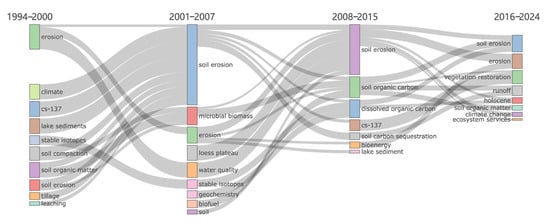
Figure 11.
R bibliometrics—thematic evolution tool traces the progression of themes in research on the effects of soil erosion on soil carbon cycling, spanning from 1994 to 2024. Time segmentation points were established in 2000, 2007, and 2015.
3.3.3. Frontier Trend Prediction
In 2002, Kleinberg proposed the burst detection algorithm [68], which can identify burst terms that appear less frequently but carry more informational significance than high-frequency terms. Since its introduction, the burst detection algorithm has become an important method for identifying research hotspots and emerging trends in a specific field [69]. In this study, the Kleinberg burst detection algorithm, built into the CiteSpace software, was employed to detect burst terms in interdisciplinary research on the impact of soil erosion on soil carbon cycling. By arranging detected burst terms into ascending order from the start time at which they became a hotspot, the top 25 burst terms were identified. These 20 burst terms were further classified as either past research hotspots or current research hotspots depending on whether their keyword popularity lasted until 2024. As shown in Figure 12, research on the impact of soil erosion on soil carbon cycling has undergone distinct stage-by-stage development over the past three decades (1994–2024). During the early stages of this research timeline (1990s), investigations predominantly explored underlying mechanisms, with soil deposition (burst intensity: 8.41) experiencing a rapid rise in research attention and organic matter (6.11) emerging as a core research focus [70,71]. Subsequently, in the 2000s, research efforts shifted towards agricultural management strategies. Comparative studies on conservation tillage (burst intensity: 8.81) and conventional tillage (10.43) reached significant research peaks [72,73,74], marking a transition to practical, application-oriented solutions for mitigating carbon losses caused by soil erosion. After 2010, terms such as spatial variability (burst intensity: 5.96) and redistribution processes (8.15) emerged with prominence, reflecting the establishment of multiscale research methodologies [75,76].
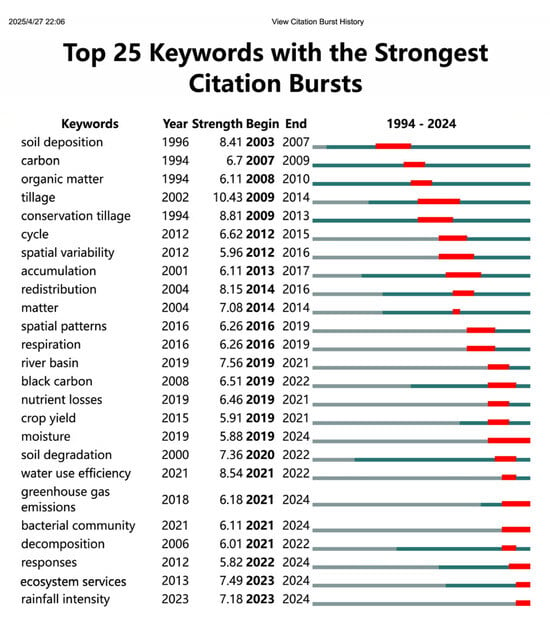
Figure 12.
Keyword emergence list ordered by the time of their occurrence.
Notably, research on the impact of soil erosion on soil carbon cycling during 2020–2024 has advanced in four key directions:
- The climate correlation direction, which includes research that focuses on the interaction mechanism between rainfall intensity (7.18) and greenhouse gas emissions (6.18) [77,78].
- The key regulatory role of the bacterial community (6.11) in the carbon cycle, which was revealed in the field of microbial mechanisms [79].
- Establishment of a high-precision quantitative method for ecosystem service assessment (7.49), which can be used in weighing ecological functions [80].
- The innovation direction, involving restoration strategies designed to optimize soil carbon sequestration by improving water use efficiency (8.54) [81].
Taken together, the emergence of these keywords, with intensity values exceeding 5, indicates that the research paradigm is changing from a single process analysis to a comprehensive study of the climate–bio–human coupling system, providing a new paradigm for the multiscale coordinated regulation of soil carbon management in the context of global change [82].
In 1988, Law et al. [83] first introduced the concept of strategic coordinates. The strategic coordinate diagram, which is based on thematic clustering (keyword clustering), visualizes the internal and external connections between themes, allowing quantitative assessment of the importance and development level of different themes in a specific field and exploration of the research hotspots, frontiers, and their development trends in a given field. As shown in Figure 13, the research themes pertinent to the impact of soil erosion on soil carbon cycling are mainly distributed in Q2 and Q4. These quadrants are mainly characterized by two overarching themes: “emerging crossover” and “professional foundation.” In the second quadrant (high centrality and low density), three key thematic clusters were formed: the “management–organic matter quality” cluster revealed the regulation mechanism of soil management on organic matter quality [84,85,86]; the “deposition–transport–redistribution” cluster focused on the landscape-scale migration process of carbon [87,88,89]; and the “sediments–records–history” cluster reconstructed the historical carbon cycle through sediment archives (for example, the tracing of carbon sources can be conducted via tracer techniques) [90,91,92]. At the same time, the three clusters of “soil erosion–organic carbon–land use,” “carbon–erosion–nitrogen”, and “runoff impact–matter” in the fourth quadrant (high density and low centrality) [93,94,95] were found to jointly construct the basic research framework in this field from the dimensions of land use impact, carbon–nitrogen coupling mechanisms, and runoff migration processes. Further combined with Figure 11, it can be seen that this cluster distribution is highly consistent with the intensity patterns of “redistribution” (8.15) and “nitrogen” (5.91) in keyword burst detection in recent years; this indicates that the study of the soil carbon cycle is changing from a single-factor analysis to a multi-process coupling system in a cognitive paradigm. Further observation in conjunction with the co-occurrence network (Figure 9b) reveals that in the retrieved 31-year dataset, although “soil erosion” is the core cluster, small-scale erosion processes (such as “catchment”, “gully erosion”, and “interrill erosion”) are still significantly correlated with carbon sinks. This indicates that the CiteSpace algorithm has covered multi-scale studies in the macro erosion–carbon correlation network, even if they are not separately highlighted as emergent terms.
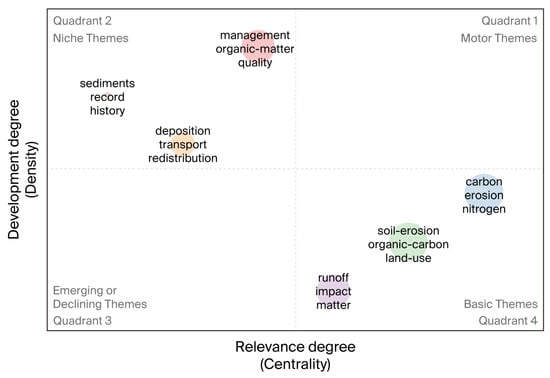
Figure 13.
Thematic map of concepts in research on the impact of soil erosion on soil carbon cycling.
4. Discussion
In the face of exponential information growth, bibliometric methods offer rapid, quantitative, and visual advantages for investigations into the dynamics and content of a certain field. While previous bibliometric studies have explored interactions between soil erosion and carbon [96,97], this study offers the first comprehensive analysis of these linkages under climate change across a 30-year timeframe (1994–2024), shedding light on emerging temporal trends and shifting research priorities. Specifically, publication trends in this field were examined; then, the co-authorship networks of researchers, institutions, and countries/regions were generated to identify the most productive researchers, institutions, and countries/regions. Additionally, keyword co-occurrence networks were utilized to identify research hotspots and predict frontier trends.
4.1. The Correlation Between Research Trends and Policy-Driven Topics
The bibliometric results showed that the growth in publications in the research field surrounding the impact of soil erosion on soil carbon cycling showed obvious stage characteristics (Figure 3). The slow development phase from 1994 to 2011 was found to correspond closely to the establishment of the global climate governance framework, including the negotiation and implementation of the Kyoto Protocol (https://ppp.worldbank.org/public-private-partnership/zh-hans/node/8239 (accessed on 25 April 2025)). Conversely, the period of rapid growth commencing in 2012 aligned well with significant milestones such as the signing of the Paris Agreement (https://www.un.org/en/climatechange/paris-agreement (accessed on 25 April 2025)) and the proposal of the “dual carbon” objectives. This trend is consistent with the findings of Lindman’s study on policy orientation to drive wind energy and the green economy in Europe [98], corroborating the role of environmental policy as a driver of research orientation [99]; additionally, this reflects the increasing importance of soil carbon cycle research in responding to climate change [77]. It is worth noting that China’s number of publications throughout 2018–2024 has surged (36.3% of the global total), and the field may benefit from the implementation of the “ecological civilization construction” strategy at the national level and the accumulation of research in typical regions such as the Loess Plateau [100,101,102].
4.2. The Evolution Characteristics of Academic Cooperation Network
The analysis of the collaboration network of researchers shows that three major transnational research clusters have been formed in this field, with Lal R (United States), Li Z (China), and Van Oost K (Belgium) comprising the core group of collaborative researchers (Figure 4). Lal R’s “erosion-induced carbon losses and CO2 emissions” theory [11] paved the way for subsequent research. The RUSLE–Carbon coupling model [103] developed by his team in recent years has significantly improved the accuracy of erosion carbon flux estimation. Chinese scholars focused on the case of the Loess Plateau and formed a research paradigm with regional characteristics through biochar improvement technologies [104,105,106] and an erosion–deposition carbon redistribution mechanism [1,10]. However, the proportion of core authors in this field is only 41.6%, and the core author group has not been formed (Price’s law threshold > 50%). This decentralized feature may be due to the interdisciplinary nature of soil carbon cycle research, which requires the integration of multidisciplinary knowledge such as soil science, ecology, and climatology [15,82]. The analysis of institutional cooperation shows that, although there is cooperation between the Chinese Academy of Sciences and institutions such as the USDA-ARS (Figure 6), the cooperation among developing countries is obviously insufficient (Figure 7c). The asymmetric collaboration patterns between developed and developing country clusters mirror the “geographical disparity” in climate research noted by Skelton et al. [107], where developing nations often face constrained access to high-resolution soil erosion and carbon cycling datasets. Our Table 4 and Figure 8 also reveal another emerging dichotomy: high impact factor journals (IF > 50) are predominantly distributed in developed countries. Our comparative case analysis reveals a recurrent pattern: while developed partners (such as the United Kingdom Meteorological Office) utilize dynamical downscaling for customized projections, many developing country networks rely on pre-configured tools like providing regional climates for impact studies [108]. This technological disparity creates systemic barriers to integrating local observational data with global collaborative frameworks.
To bridge these gaps, we propose strengthening the cooperation mechanism through (a) Global North and Global South training programs on advanced erosion–carbon model customization and building recommendations for early-career scientist support [109]; (b) tiered data-sharing agreements accounting for intellectual property concerns [110]; and (c) policy-aligned collaboration frameworks that reconcile national priorities, as highlighted in Blicharska et al. (2017) for addressing the North–South divide in environmental research [111].
4.3. Gradient Difference of National Scientific Research Competitiveness
From the perspective of national scientific research output, China and the United States have formed a “bipolar pattern”: researchers in China rank first in terms of the number of published papers, with 1439 papers, but researchers in the United States maintain their academic influence/advantage with their H-index (117) and total number of citations (52,297) (Table 3). This difference stems from the accumulation of long-term observation data (such as the USDA-ARS century farmland erosion sequence [112]) and process models (such as WEPP–Carbon [113]) in the United States. Although China has made breakthroughs in the erosion carbon cycle of the Loess Plateau [100,101,102] and the migration of organic carbon in karst areas [114,115], there is still room for improvement in theoretical innovation and model originality.
4.4. Suggestions for Future Research
Based on the aforementioned trends, future research endeavors should primarily focus on the directions summarized in the following subsections.
4.4.1. Building a Deeper Understanding of Fundamental Mechanisms
To advance this field of study, future research should employ isotope tracer techniques, such as 13C, to systematically examine the stability and morphological changes in carbon that occur during the erosion–deposition processes. This approach will enable a more in-depth exploration of the underlying mechanisms governing the dynamics of soil carbon across diverse environmental conditions.
4.4.2. Innovation in Technological Methodologies
The revised universal soil loss equation (RUSLE) model was seamlessly integrated with the InVEST (integrated assessment of ecosystem services and trade-offs) assessment tool to build a coupling platform [116,117]. The cascade effect of soil erosion and ecosystem processes and services is simulated to improve the prediction accuracy and decision support ability of soil–ecosystem collaborative management.
4.4.3. Expanding Policy-Relevant Applications
It is important to actively incorporate soil-erosion-induced carbon sink/source effect management measures into the implementation frameworks of the “land degradation neutrality” (LDN) target. For example, through the development of policy guidelines, incentive mechanisms, and monitoring systems, the multiple objectives of promoting sustainable land use while reducing carbon loss caused by soil erosion and strengthening the land’s ability to adapt to climate change can be achieved [118,119].
Moreover, research in fragile ecosystems (including tropical regions and permafrost) needs to be strengthened. Although they have a special position in the global carbon cycle and are highly sensitive to climate change, these regions are underrepresented in the existing literature due to the uneven coverage of the study area [120,121]. By filling these geographical gaps, researchers can build a more comprehensive understanding of the mechanisms of the impact of soil erosion on soil carbon cycling under different environmental backgrounds; thus, they can develop more effective and globally applicable protection and management strategies.
5. Conclusions
This study utilized the VOSviewer software, CiteSpace, and an online bibliometric analysis platform to conduct bibliometric and visual analyses of articles (indexed in the WoS Core Collection database) that have been published in the past 31 years on the impact of soil erosion on soil carbon cycling. A total of 3880 articles published between 1994 and 2024 were retrieved. The findings indicate that, as carbon neutrality and peak carbon emissions have increasingly become research hotspots, the impact of soil erosion on soil carbon cycling has emerged as an indispensable research direction; however, it is still in a rapid development phase. Currently, research in this field is mainly concentrated in high-productivity countries, with the United States maintaining a dominant position and China rapidly developing with a scale advantage. International cross-border cooperation needs to be strengthened among authors, institutions, and countries, particularly for countries with low productivity. Furthermore, ecosystem services currently comprise the most prominent research hotspot in this field. The integration of soil microbiology with carbon stability mechanisms, the coupled application of isotope geochemistry and process-based models, the innovative combination of remote sensing big data with ecosystem service assessment, and the exploration of synergistic pathways between policy science and ecological economics are areas that are likely to become research hotspots in the future. This study employs bibliometrics and knowledge mapping techniques to provide a large-scale, quantitative, and visualized analysis of the soil erosion on soil carbon cycling, offering a systematic perspective complementary to existing literature. The results are systematically outlined in terms of research themes, knowledge evolution, hotspot themes, and development trends in this field over the past 31 years. The methods and analytical processes used herein can serve as a reference for similar studies in the future and can be extended and applied to research in other disciplines. However, it should be noted that this study has limitations. First and foremost, bibliometric findings are inherently time-sensitive, as they are contingent upon the literature snapshot captured at the time of database query (in this study: 30 March 2025). Although the research landscape is continuously expanded by emerging publications, our analysis prioritizes the identification of robust, long-term trends up to the specified search date. Future iterations of this work could refine these observations by integrating post-2024 developments. Additionally, the possibility of generating inconsistent analysis results due to differences in the selection of data sources (including not only variations between databases like Scopus, Engineering Index, and WoS, but also potential underrepresentation of non-English literature across these platforms) and differences in software parameter settings.
Author Contributions
Conceptualization, X.Y. and Y.L.; methodology, Y.L.; software, Y.Z.; validation, X.Z., X.Y. and X.W.; formal analysis, Y.L.; resources, L.S.; data curation, X.Z.; writing—original draft preparation, Y.L.; writing—review and editing, X.Z.; visualization, Y.Z.; project administration, X.W. All authors have read and agreed to the published version of the manuscript.
Funding
This study was financially supported by the Spatial and Temporal Characteristics of Soil Erosion and Spatial Delineation of Ecological Restoration in Wind-Water Compound Erosion Areas (Grant No. 2024JBGS0023); Delimitation Project of Key Soil and Water Conservation Areas in Ningxia Hui Autonomous Region (SE120203A0142024) and the special research project of the China Institute of Water Resources and Hydropower Research (SE110145B0062025).
Institutional Review Board Statement
Not applicable.
Informed Consent Statement
Not applicable.
Data Availability Statement
All data sources and acquisition methods have been clarified in the text, and they may also be obtained from the corresponding author upon reasonable request.
Acknowledgments
We gratefully acknowledge the State Key Laboratory of Simulation and Regulation of Water Cycle in River Basin (Beijing 100038, China) for providing data retrieval platform support.
Conflicts of Interest
The authors declare no conflicts of interest.
Abbreviations
The following abbreviations are used in this manuscript:
| USDA-ARSI | United States Department of Agriculture—Agricultural Research Service |
| WEPP | Water Erosion Prediction Project |
| H | H-index |
| IF | journal impact factors |
| RUSLE | the Revised Universal Soil Loss Equation |
| Bibliometric–SLR | Bibliometric–Systematic Literature Review |
| US | United States |
| COTC | sum of times cited |
| CSIC | Spanish National Research Council |
| TLS | total link strength |
| SOC | soil organic carbon |
| SIC | soil inorganic carbon |
| LDN | land degradation neutrality |
| WoS | Web of Science |
| North–South | Global North and Global South |
References
- Hu, T.; Sun, Y. Interpretation of IPCC AR6 on human influence on the climate system. Clim. Change Res. 2021, 17, 644–651. [Google Scholar] [CrossRef]
- Zou, C.; Ma, F.; Pan, S.; Lin, M.; Zhang, G.; Xiong, B.; Wang, Y.; Liang, Y.; Yang, Z. Earth energy evolution, human development and carbon neutral strategy. Pet. Explor. Dev. 2022, 49, 468–488. [Google Scholar] [CrossRef]
- Chen, L.-F.; He, Z.-B.; Du, J.; Yang, J.-J.; Zhu, X. Patterns and environmental controls of soil organic carbon and total nitrogen in alpine ecosystems of northwestern China. Catena 2016, 137, 37–43. [Google Scholar] [CrossRef]
- Lal, R. Soil carbon sequestration impacts on global climate change and food security. Science 2004, 304, 1623–1627. [Google Scholar] [CrossRef] [PubMed]
- Stockmann, U.; Adams, M.A.; Crawford, J.W.; Field, D.J.; Henakaarchchi, N.; Jenkins, M.; Minasny, B.; McBratney, A.B.; de Remy de Courcelles, V.; Singh, K.; et al. The knowns, known unknowns and unknowns of sequestration of soil organic carbon. Agric. Ecosyst. Environ. 2013, 164, 80–99. [Google Scholar] [CrossRef]
- Dynarski, K.A.; Bossio, D.A.; Scow, K.M. Dynamic stability of soil carbon: Reassessing the “permanence” of soil carbon sequestration. Front. Environ. Sci. 2020, 8, 514701. [Google Scholar] [CrossRef]
- Yang, J.; Li, A.; Yang, Y.; Li, G.; Zhang, F. Soil organic carbon stability under natural and anthropogenic-induced perturbations. Earth-Sci. Rev. 2020, 205, 103199. [Google Scholar] [CrossRef]
- Mueller-Nedebock, D.; Chaplot, V. Soil carbon losses by sheet erosion: A potentially critical contribution to the global carbon cycle. Earth Surf. Process. Landf. 2015, 40, 1803–1813. [Google Scholar] [CrossRef]
- Chaplot, V.; Cooper, M. Soil aggregate stability to predict organic carbon outputs from soils. Geoderma 2015, 243, 205–213. [Google Scholar] [CrossRef]
- Ran, L.; Fang, N.; Wang, X.; Piao, S.; Chan, C.N.; Li, S.; Zeng, Y.; Shi, Z.; Tian, M.; Xu, Y.J. Substantially enhanced landscape carbon sink due to reduced terrestrial-aquatic carbon transfer through soil conservation in the Chinese Loess Plateau. Earth’s Future 2023, 11, e2023EF003602. [Google Scholar] [CrossRef]
- Lal, R. Soil erosion and the global carbon budget. Environ. Int. 2003, 29, 437–450. [Google Scholar] [CrossRef]
- Lugato, E.; Smith, P.; Borrelli, P.; Panagos, P.; Ballabio, C.; Orgiazzi, A.; Fernandez-Ugalde, O.; Montanarella, L.; Jones, A. Soil erosion is unlikely to drive a future carbon sink in Europe. Sci. Adv. 2018, 4, eaau3523. [Google Scholar] [CrossRef]
- de Nijs, E.A.; Cammeraat, E.L.H. The stability and fate of soil organic carbon during the transport phase of soil erosion. Earth-Sci. Rev. 2020, 201, 103067. [Google Scholar] [CrossRef]
- Berhe, A.A.; Barnes, R.T.; Six, J.; Marín-Spiotta, E. Role of soil erosion in biogeochemical cycling of essential elements: Carbon, nitrogen, and phosphorus. Annu. Rev. Earth Planet Sci. 2018, 46, 521–548. [Google Scholar] [CrossRef]
- Doetterl, S.; Berhe, A.A.; Nadeu, E.; Wang, Z.; Sommer, M.; Fiener, P. Erosion, deposition and soil carbon: A review of process-level controls, experimental tools and models to address C cycling in dynamic landscapes. Earth-Sci. Rev. 2016, 154, 102–122. [Google Scholar] [CrossRef]
- Hilton, R.G.; West, A.J. Mountains, erosion and the carbon cycle. Nat. Rev. Earth Environ. 2020, 1, 284–299. [Google Scholar] [CrossRef]
- Lal, R. Soil erosion and gaseous emissions. Appl. Sci. 2020, 10, 2784. [Google Scholar] [CrossRef]
- Liu, L.; Zhang, Q.; Liu, Q.; Li, Z. Is soil an organic carbon sink or source upon erosion, transport and deposition? Eur. J. Soil Sci. 2023, 74, e13344. [Google Scholar] [CrossRef]
- Aguirre-Salado, O.T.; Pérez-Nieto, J.; Aguirre-Salado, C.A.; Monterroso-Rivas, A.I.; Gallardo-Lancho, J.F. Water erosion, soil organic carbon redistribution and soil and water conservation: A review. Rev. Chapingo Ser. Cienc. For. Ambient. 2023, 29, 47–60. [Google Scholar] [CrossRef]
- Abney, R.B.; Berhe, A.A. Pyrogenic carbon erosion: Implications for stock and persistence of pyrogenic carbon in soil. Front. Earth Sci. 2018, 6, 26. [Google Scholar] [CrossRef]
- Merigo, J.M.; Gil-Lafuente, A.M.; Yager, R.R. An overview of fuzzy research with bibliometric indicators. Appl. Soft Comput. 2015, 27, 420–433. [Google Scholar] [CrossRef]
- Geng, Y.; Zhu, R.; Maimaituerxun, M. Bibliometric review of carbon neutrality with CiteSpace: Evolution, trends, and framework. Environ. Sci. Pollut. Res. 2022, 29, 76668–76686. [Google Scholar] [CrossRef]
- Chen, Y.; Chen, C.; Liu, Z.; Hu, Z.; Wang, X. The methodology function of CiteSpace mapping knowledge domains. Stud. Sci. Sci. 2015, 33, 242–253. [Google Scholar] [CrossRef]
- Chen, C. Visualizing and exploring scientific literature with CiteSpace: An introduction to a half-day tutorial. In Proceedings of the 2018 Conference on Human Information Interaction & Retrieval-CHIIR ‘18, New Brunswick, NJ, USA, 11–15 March 2018; ACM Press: New Brunswick, NJ, USA, 2018; pp. 369–370. [Google Scholar] [CrossRef]
- Jeong, D.-h.; Koo, Y. Analysis of Trend and Convergence for Science and Technology using the VOSviewer. Int. J. Contents 2016, 12, 54–58. [Google Scholar] [CrossRef]
- Stallard, R.F. Terrestrial sedimentation and the carbon cycle: Coupling weathering and erosion to carbon burial. Glob. Biogeochem. Cycles 1998, 12, 231–257. [Google Scholar] [CrossRef]
- Imeson, A.; Lavee, H. Soil erosion and climate change: The transect approach and the influence of scale. Geomorphology 1998, 23, 219–227. [Google Scholar] [CrossRef]
- Berhe, A.A.; Harte, J.; Harden, J.W.; Torn, M.S. The significance of the erosion-induced terrestrial carbon sink. BioScience 2007, 57, 337–346. [Google Scholar] [CrossRef]
- Chadwick, O.A.; Kelly, E.F.; Merritts, D.M.; Amundson, R.G. Carbon dioxide consumption during soil development. Biogeochemistry 1994, 24, 115–127. [Google Scholar] [CrossRef]
- Coelho, C.A.d.S. Knowledge Coproduction in Climate Services: European Experiences and the Brazilian Scenario Evaluation. 2018. Available online: https://webofscience.clarivate.cn/wos/alldb/full-record/GRANTS:16387273 (accessed on 9 July 2025).
- Visseren-Hamakers, I.J.; Gupta, A.; Herold, M.; Pena-Claros, M.; Vijge, M.J. Will REDD+ work? The need for interdisciplinary research to address key challenges. Curr. Opin. Environ. Sustain. 2012, 4, 590–596. [Google Scholar] [CrossRef]
- United Nations Framework Convention on Climate Change (UNFCCC). Science in the UNFCCC Negotiations; United Nations Framework Convention on Climate Change: Bonn, Germany, 2025. Available online: https://unfccc.int/topics/science/the-big-picture/science-in-the-unfccc-negotiations (accessed on 9 July 2025).
- Hwang, G.-J.; Tu, Y.-F. Roles and research trends of artificial intelligence in mathematics education: A bibliometric mapping analysis and systematic review. Mathematics 2021, 9, 584. [Google Scholar] [CrossRef]
- Pan, W.; Zheng, P.; Huang, J.; Mu, D.; Li, Y. Research hotspot detection of health information based on the “DEAN” process of data clean. Mod. Inf. 2018, 38, 73–77. [Google Scholar] [CrossRef]
- Marzi, G.; Balzano, M.; Caputo, A.; Pellegrini, M.M. Guidelines for Bibliometric-Systematic Literature Reviews: 10 steps to combine analysis, synthesis and theory development. Int. J. Manag. Rev. 2025, 27, 81–103. [Google Scholar] [CrossRef]
- Sood, S.K.; Rawat, K.S.; Kumar, D. Analytical mapping of information and communication technology in emerging infectious diseases using CiteSpace. Telemat. Inform. 2022, 69, 101796. [Google Scholar] [CrossRef] [PubMed]
- Sood, S.K.; Rawat, K.S. Fog-assisted virtual reality-based learning framework to control panic. Expert Syst. 2022, 39, e12700. [Google Scholar] [CrossRef]
- Arruda, H.; Silva, E.R.; Lessa, M.; Proença, D., Jr.; Bartholo, R. VOSviewer and Bibliometrix. J. Med. Libr. Assoc. 2022, 110, 392–395. [Google Scholar] [CrossRef]
- van Eck, N.J.; Waltman, L. Software survey: VOSviewer, a computer program for bibliometric mapping. Scientometrics 2010, 84, 523–538. [Google Scholar] [CrossRef]
- Chen, C. CiteSpace II: Detecting and visualizing emerging trends and transient patterns in scientific literature. J. Am. Soc. Inf. Sci. Technol. 2006, 57, 359–377. [Google Scholar] [CrossRef]
- Long, H.; Zhang, Y.; Ma, L.; Tu, S. Land use transitions: Progress, challenges and prospects. Land 2021, 10, 903. [Google Scholar] [CrossRef]
- Bornmann, L.; Haunschild, R.; Mutz, R. Growth rates of modern science: A latent piecewise growth curve approach to model publication numbers from established and new literature databases. Humanit. Soc. Sci. Commun. 2021, 8, 224. [Google Scholar] [CrossRef]
- Imperial, J.; Rodríguez-Navarro, A. Usefulness of Hirsch’s h-index to evaluate scientific research in Spain. Scientometrics 2007, 71, 271–282. [Google Scholar] [CrossRef]
- Norris, M.; Oppenheim, C. The h-index: A broad review of a new bibliometric indicator. J. Doc. 2010, 66, 681–705. [Google Scholar] [CrossRef]
- Shi, X.; Zhang, J.; Lu, S.; Wang, T.; Zhang, X. China carbon neutralization research status and research frontier tracking. Front. Environ. Sci. 2022, 10, 896524. [Google Scholar] [CrossRef]
- Price, D.J.D.S. Little Science, Big Science; Columbia University Press: New York, NY, USA, 1963. [Google Scholar] [CrossRef]
- Li, X.; Hu, S.; Jiang, L.; Han, B.; Li, J.; Wei, X. Bibliometric analysis of the research (2000–2020) on Land-use carbon emissions based on CiteSpace. Land 2023, 12, 165. [Google Scholar] [CrossRef]
- Chen, S.; Lu, Q.; Bai, J.; Deng, C.; Wang, Y.; Zhao, Y. Global publications on stigma between 1998–2018: A bibliometric analysis. J. Affect. Disord. 2020, 274, 363–371. [Google Scholar] [CrossRef] [PubMed]
- Liu, D.; Che, S.; Zhu, W. Visualizing the knowledge domain of academic mobility research from 2010 to 2020: A bibliometric analysis using CiteSpace. SAGE Open 2022, 12, 215824402110685. [Google Scholar] [CrossRef]
- Li, M.; Li, X.; Shi, Y.; Jiang, Y.; Xue, R.; Zhang, Q. Soil enzyme activity mediated organic carbon mineralization due to soil erosion in long gentle sloping farmland in the black soil region. Sci. Total Environ. 2024, 929, 172417. [Google Scholar] [CrossRef]
- Bianchi, T.S.; Mayer, L.M.; Amaral, J.H.; Arndt, S.; Galy, V.; Kemp, D.B.; Kuehl, S.A.; Murray, N.J.; Regnier, P. Anthropogenic impacts on mud and organic carbon cycling. Nat. Geosci. 2024, 17, 287–297. [Google Scholar] [CrossRef]
- Borrelli, P.; Robinson, D.A.; Panagos, P.; Lugato, E.; Yang, J.E.; Alewell, C.; Wuepper, D.; Montanarella, L.; Ballabio, C. Land use and climate change impacts on global soil erosion by water (2015–2070). Proc. Natl. Acad. Sci. USA 2020, 117, 21994–22001. [Google Scholar] [CrossRef]
- Cheng, Y.; Luo, P.; Yang, H.; Li, M.; Ni, M.; Li, H.; Huang, Y.; Xie, W.; Wang, L. Land use and cover change accelerated China’s land carbon sinks limits soil carbon. npj Clim. Atmos. Sci. 2024, 7, 199. [Google Scholar] [CrossRef]
- Yang, R.; Yang, S.; Chen, L.-l.; Yang, Z.; Xu, L.; Zhang, X.; Liu, G.; Jiao, C.; Bai, R.; Zhang, X. Effect of vegetation restoration on soil erosion control and soil carbon and nitrogen dynamics: A meta-analysis. Soil Tillage Res. 2023, 230, 105705. [Google Scholar] [CrossRef]
- Zheng, H.; Miao, C.; Huntingford, C.; Tarolli, P.; Li, D.; Panagos, P.; Yue, Y.; Borrelli, P.; Van Oost, K. The impacts of erosion on the carbon cycle. Rev. Geophys. 2025, 63, e2023RG000829. [Google Scholar] [CrossRef]
- Boardman, J.; Favis-Mortlock, D. Climate change and soil erosion in Britain. Geogr. J. 1993, 159, 179–183. [Google Scholar] [CrossRef]
- McGuire, A.D.; Melillo, J.M.; Kicklighter, D.W.; Joyce, L.A. Equilibrium responses of soil carbon to climate change: Empirical and process-based estimates. J. Biogeogr. 1995, 22, 785–796. [Google Scholar] [CrossRef]
- Wang, K.-B.; Deng, L.; Di, D.-R.; He, X.-H.; Shi, W.-Y. Tracking soil carbon processes in two temperate forests at different successional stages using stable and radioactive carbon isotopes. Agric. Ecosyst. Environ. 2020, 304, 107143. [Google Scholar] [CrossRef]
- Gregory, A.; Ritz, K.; McGrath, S.; Quinton, J.; Goulding, K.; Jones, R.; Harris, J.; Bol, R.; Wallace, P.; Pilgrim, E. A review of the impacts of degradation threats on soil properties in the UK. Soil Use Manag. 2015, 31, 1–15. [Google Scholar] [CrossRef] [PubMed]
- Dungait, J.A.; Ghee, C.; Rowan, J.S.; McKenzie, B.M.; Hawes, C.; Dixon, E.R.; Paterson, E.; Hopkins, D.W. Microbial responses to the erosional redistribution of soil organic carbon in arable fields. Soil Biol. Biochem. 2013, 60, 195–201. [Google Scholar] [CrossRef]
- Woolf, D.; Amonette, J.E.; Street-Perrott, F.A.; Lehmann, J.; Joseph, S. Sustainable biochar to mitigate global climate change. Nat. Commun. 2010, 1, 56. [Google Scholar] [CrossRef]
- Li, Z.; Xiao, H.; Tang, Z.; Huang, J.; Nie, X.; Huang, B.; Ma, W.; Lu, Y.; Zeng, G. Microbial responses to erosion-induced soil physico-chemical property changes in the hilly red soil region of southern China. Eur. J. Soil Biol. 2015, 71, 37–44. [Google Scholar] [CrossRef]
- Zhang, X.; Li, Z.; Nie, X.; Huang, M.; Wang, D.; Xiao, H.; Liu, C.; Peng, H.; Jiang, J.; Zeng, G. The role of dissolved organic matter in soil organic carbon stability under water erosion. Ecol. Indic. 2019, 102, 724–733. [Google Scholar] [CrossRef]
- Pang, D.; Xu, H. Carbon Sequestration and Stability and Soil Erosion in Forest Ecosystems. Ecol. Indic. 2024, 15, 1961. [Google Scholar] [CrossRef]
- Tianjiao, F.; Tianxing, W.; Keesstra, S.D.; Jianjun, Z.; Huaxing, B.; Ruoshui, W.; Ping, W. Long-term effects of vegetation restoration on hydrological regulation functions and the implications to afforestation on the Loess Plateau. Agric. For. Meteorol. 2023, 330, 109313. [Google Scholar] [CrossRef]
- de Araujo Pereira, A.P.; Mendes, L.W.; Oliveira, F.A.S.; Antunes, J.E.L.; Melo, V.M.M.; Araujo, A.S.F. Land degradation affects the microbial communities in the Brazilian Caatinga biome. Catena 2022, 211, 105961. [Google Scholar] [CrossRef]
- Zong, R.; Fang, N.; Zeng, Y.; Lu, X.; Wang, Z.; Dai, W.; Shi, Z. Soil conservation benefits of ecological programs promote sustainable restoration. Earth’s Future 2025, 13, e2024EF005287. [Google Scholar] [CrossRef]
- Kleinberg, J. Bursty and hierarchical structure in streams. Data Min. Knowl. Discov. 2003, 7, 373–397. [Google Scholar] [CrossRef]
- Kontostathis, A.; Galitsky, L.M.; Pottenger, W.M.; Roy, S.; Phelps, D.J. A Survey of Emerging Trend Detection in Textual Data Mining. In Survey of Text Mining: Clustering, Classification, and Retrieval; Berry, M.W., Ed.; Springer: New York, NY, USA, 2004; pp. 185–224. [Google Scholar] [CrossRef]
- Gregorich, E.; Greer, K.; Anderson, D.; Liang, B. Carbon distribution and losses: Erosion and deposition effects. Soil Tillage Res. 1998, 47, 291–302. [Google Scholar] [CrossRef]
- Harden, J.; Sharpe, J.; Parton, W.; Ojima, D.; Fries, T.; Huntington, T.G.; Dabney, S. Dynamic replacement and loss of soil carbon on eroding cropland. Glob. Biogeochem. Cycles 1999, 13, 885–901. [Google Scholar] [CrossRef]
- Six, J.; Elliott, E.T.; Paustian, K. Soil macroaggregate turnover and microaggregate formation: A mechanism for C sequestration under no-tillage agriculture. Soil Biol. Biochem. 2000, 32, 2099–2103. [Google Scholar] [CrossRef]
- Van Oost, K.; Govers, G.; Quine, T.A.; Heckrath, G.; Olesen, J.E.; De Gryze, S.; Merckx, R. Landscape-scale modeling of carbon cycling under the impact of soil redistribution: The role of tillage erosion. Glob. Biogeochem. Cycles 2005, 19, GB4014. [Google Scholar] [CrossRef]
- Van Oost, K.; Quine, T.A.; Govers, G.; De Gryze, S.; Six, J.; Harden, J.W.; Ritchie, J.C.; McCarty, G.W.; Heckrath, G.; Kosmas, C.; et al. The impact of agricultural soil erosion on the global carbon cycle. Science 2007, 318, 626–629. [Google Scholar] [CrossRef]
- Berhe, A.A.; Harden, J.W.; Torn, M.S.; Kleber, M.; Burton, S.D.; Harte, J. Persistence of soil organic matter in eroding versus depositional landform positions. J. Geophys. Res. Biogeosci. 2012, 117, G02019. [Google Scholar] [CrossRef]
- Wang, X.; Cammeraat, E.L.; Romeijn, P.; Kalbitz, K. Soil organic carbon redistribution by water erosion–the role of CO2 emissions for the carbon budget. PLoS ONE 2014, 9, e96299. [Google Scholar] [CrossRef]
- Naipal, V.; Ciais, P.; Wang, Y.; Lauerwald, R.; Guenet, B.; Van Oost, K. Global soil organic carbon removal by water erosion under climate change and land use change during AD 1850–2005. Biogeosciences 2018, 15, 4459–4480. [Google Scholar] [CrossRef]
- Nearing, M.; Pruski, F.; O’neal, M. Expected climate change impacts on soil erosion rates: A review: Conservation Implications of Climate Change. J. Soil Water Conserv. 2004, 59, 43–50. [Google Scholar] [CrossRef]
- Qiu, L.; Zhang, Q.; Zhu, H.; Reich, P.B.; Banerjee, S.; van der Heijden, M.G.; Sadowsky, M.J.; Ishii, S.; Jia, X.; Shao, M. Erosion reduces soil microbial diversity, network complexity and multifunctionality. ISME J. 2021, 15, 2474–2489. [Google Scholar] [CrossRef]
- Steinhoff-Knopp, B.; Kuhn, T.K.; Burkhard, B. The impact of soil erosion on soil-related ecosystem services: Development and testing a scenario-based assessment approach. Environ. Monit. Assess. 2021, 193, 274. [Google Scholar] [CrossRef] [PubMed]
- Zhang, L.; Xiao, J.; Zheng, Y.; Li, S.; Zhou, Y. Increased carbon uptake and water use efficiency in global semi-arid ecosystems. Environ. Res. Lett. 2020, 15, 034022. [Google Scholar] [CrossRef]
- Zhang, J.; Zhang, C.; Ma, W.; Wang, W.; Li, H. Improving the Model Performance of the Ecosystem Carbon Cycle by Integrating Soil Erosion–Related Processes. Atmosphere 2023, 14, 1724. [Google Scholar] [CrossRef]
- Law, J.; Bauin, S.; Courtial, J.P.; Whittaker, J. Policy and the mapping of scientific change—A co-word analysis of research into environmental acidification. Scientometrics 1988, 14, 251–264. [Google Scholar] [CrossRef]
- Karlen, D.; Cambardella, C. Conservation Strategies for Improving Soil Quality and Organic Matter Storage. In Structure and Organic Matter Storage in Agricultural Soils; Carter, M.R., Stewart, B.A., Eds.; CRC Press: Boca Raton, FL, USA, 1995; pp. 395–420. [Google Scholar] [CrossRef]
- Githongo, M.; Ngatia, L.; Kiboi, M.; Muriuki, A.; Fliessbach, A.; Musafiri, C.; Fu, R.; Ngetich, F. The structural quality of soil organic matter under selected soil fertility management practices in the central highlands of Kenya. Sustainability 2023, 15, 6500. [Google Scholar] [CrossRef]
- Gabbarini, L.A.; Figuerola, E.; Frene, J.P.; Robledo, N.B.; Ibarbalz, F.M.; Babin, D.; Smalla, K.; Erijman, L.; Wall, L.G. Impacts of switching tillage to no-tillage and vice versa on soil structure, enzyme activities and prokaryotic community profiles in Argentinean semi-arid soils. FEMS Microbiol. Ecol. 2021, 97, fiab025. [Google Scholar] [CrossRef]
- Kirkels, F.; Cammeraat, L.; Kuhn, N. The fate of soil organic carbon upon erosion, transport and deposition in agricultural landscapes—A review of different concepts. Geomorphology 2014, 226, 94–105. [Google Scholar] [CrossRef]
- Öttl, L.K.; Wilken, F.; Juřicová, A.; Batista, P.V.; Fiener, P. A millennium of arable land use–the long-term impact of tillage and water erosion on landscape-scale carbon dynamics. Soil 2024, 10, 281–305. [Google Scholar] [CrossRef]
- Olson, K.R.; Gennadiyev, A.N.; Zhidkin, A.P.; Markelov, M.V. Impacts of Land-Use Change, Slope, and Erosion on Soil Organic Carbon Retention and Storage. Soil Sci. 2012, 177, 269–278. [Google Scholar] [CrossRef]
- Tan, Z.; Leung, L.R.; Li, H.Y.; Tesfa, T.; Zhu, Q.; Huang, M. A substantial role of soil erosion in the land carbon sink and its future changes. Glob. Change Biol. 2020, 26, 2642–2655. [Google Scholar] [CrossRef]
- Li, L.; Krenz, J.; Pregler, A.; Greenwood, P.; Kuhn, N.J. The Potential to Reconstruct 20th Century Soil Organic Carbon Erosion in Rangelands from Small Reservoir Sediments. Land Degrad. Dev. 2024, 35, 5671–5686. [Google Scholar] [CrossRef]
- Wynants, M.; Patrick, A.; Munishi, L.; Mtei, K.; Bodé, S.; Taylor, A.; Millward, G.; Roberts, N.; Gilvear, D.; Ndakidemi, P. Soil erosion and sediment transport in Tanzania: Part II–sedimentological evidence of phased land degradation. Earth Surf. Process. Landf. 2021, 46, 3112–3126. [Google Scholar] [CrossRef]
- Holz, M.; Augustin, J. Erosion effects on soil carbon and nitrogen dynamics on cultivated slopes: A meta-analysis. Geoderma 2021, 397, 115045. [Google Scholar] [CrossRef]
- Keesstra, S.; Mol, G.; De Leeuw, J.; Okx, J.; De Cleen, M.; Visser, S. Soil-related sustainable development goals: Four concepts to make land degradation neutrality and restoration work. Land 2018, 7, 133. [Google Scholar] [CrossRef]
- Olson, K.R.; Al-Kaisi, M.; Lal, R.; Cihacek, L. Impact of soil erosion on soil organic carbon stocks. J. Soil Water Conserv. 2016, 71, 61A–67A. [Google Scholar] [CrossRef]
- Raza, S.; Irshad, A.; Margenot, A.; Zamanian, K.; Li, N.; Ullah, S.; Mehmood, K.; Khan, M.A.; Siddique, N.; Zhou, J. Inorganic carbon is overlooked in global soil carbon research: A bibliometric analysis. Geoderma 2024, 443, 116831. [Google Scholar] [CrossRef]
- Feng, Z.; Miao, Q.; Shi, H.; Li, X.; Yan, J.; Gonçalves, J.M.; Yu, D.; Yan, Y.; Feng, W. Global trends and networks in soil fertility enhancement techniques: A bibliometric analysis. J. Soil Sci. Plant Nutr. 2024, 24, 4099–4117. [Google Scholar] [CrossRef]
- Lindman, A.; Söderholm, P. Wind energy and green economy in Europe: Measuring policy-induced innovation using patent data. Appl. Energy 2016, 179, 1351–1359. [Google Scholar] [CrossRef]
- Popp, D. Innovation and Climate Policy. In Annual Review of Resource Economics; Rausser, G.C., Smith, V.K., Zilberman, D., Eds.; Annual Reviews: Palo Alto, CA, USA, 2010; Volume 2, pp. 275–298. [Google Scholar] [CrossRef]
- Yang, Y.; Sun, H.; Zhang, P.; Wu, F.; Qiao, J.; Li, T.; Wang, Y.; An, S. Review of Managing Soil Organic C Sequestration from Vegetation Restoration on the Loess Plateau. Forests 2023, 14, 1964. [Google Scholar] [CrossRef]
- Wen, X.; Zhen, L. Soil erosion control practices in the Chinese Loess Plateau: A systematic review. Environ. Dev. 2020, 34, 100493. [Google Scholar] [CrossRef]
- Zhao, J.; Feng, X.; Deng, L.; Yang, Y.; Zhao, Z.; Zhao, P.; Peng, C.; Fu, B. Quantifying the Effects of Vegetation Restorations on the Soil Erosion Export and Nutrient Loss on the Loess Plateau. Front. Plant Sci. 2020, 11, 573126. [Google Scholar] [CrossRef]
- Lal, R. Accelerated Soil erosion as a source of atmospheric CO2. Soil Tillage Res. 2019, 188, 35–40. [Google Scholar] [CrossRef]
- Ding, Y.; Liu, Y.; Liu, S.; Li, Z.; Tan, X.; Huang, X.; Zeng, G.; Zhou, L.; Zheng, B. Biochar to improve soil fertility: A review. Agron. Sustain. Dev. 2016, 36, 36. [Google Scholar] [CrossRef]
- Li, Z.; Liu, C.; Dong, Y.; Chang, X.; Nie, X.; Liu, L.; Xiao, H.; Lu, Y.; Zeng, G. Response of soil organic carbon and nitrogen stocks to soil erosion and land use types in the Loess hilly-gully region of China. Soil Tillage Res. 2017, 166, 1–9. [Google Scholar] [CrossRef]
- Liu, C.; Li, Z.; Chang, X.; He, J.; Nie, X.; Liu, L.; Xiao, H.; Wang, D.; Peng, H.; Zeng, G. Soil carbon and nitrogen sources and redistribution as affected by erosion and deposition processes: A case study in a loess hilly-gully catchment, China. Agric. Ecosyst. Environ. 2018, 253, 11–22. [Google Scholar] [CrossRef]
- Skelton, M.; Porter, J.J.; Dessai, S.; Bresch, D.N.; Knutti, R. Customising global climate science for national adaptation: A case study of climate projections in UNFCCC’s National Communications. Environ. Sci. Policy 2019, 101, 16–23. [Google Scholar] [CrossRef]
- Mahony, M.; Hulme, M. Model migrations: Mobility and boundary crossings in regional climate prediction. Trans. Inst. Br. Geogr. 2012, 37, 197–211. [Google Scholar] [CrossRef]
- Dike, V.N.; Addi, M.; Andang’o, H.A.; Attig, B.F.; Barimalala, R.; Diasso, U.J.; Du Plessis, M.; Lamine, S.; Mongwe, P.N.; Zaroug, M. Obstacles facing Africa’s young climate scientists. Nat. Clim. Change 2018, 8, 447–449. [Google Scholar] [CrossRef]
- Verhulst, S.G. The need for climate data stewardship: 10 tensions and reflections regarding climate data governance. Data Policy 2024, 6, e52. [Google Scholar] [CrossRef]
- Blicharska, M.; Smithers, R.J.; Kuchler, M.; Agrawal, G.K.; Gutiérrez, J.M.; Hassanali, A.; Huq, S.; Koller, S.H.; Marjit, S.; Mshinda, H.M.; et al. Steps to overcome the North–South divide in research relevant to climate change policy and practice. Nat. Clim. Change 2017, 7, 21–27. [Google Scholar] [CrossRef]
- Borrelli, P.; Robinson, D.A.; Fleischer, L.R.; Lugato, E.; Ballabio, C.; Alewell, C.; Meusburger, K.; Modugno, S.; Schütt, B.; Ferro, V.; et al. An assessment of the global impact of 21st century land use change on soil erosion. Nat. Commun. 2017, 8, 2013. [Google Scholar] [CrossRef] [PubMed]
- Pruski, F.; Nearing, M. Climate-induced changes in erosion during the 21st century for eight US locations. Water Resour. Res. 2002, 38, 34-1–34-11. [Google Scholar] [CrossRef]
- Wang, K.; Sheng, M.; Wang, L.; He, Y.; Guo, C. Response of soil phytolith occluded organic carbon accumulation to long-term vegetation restoration in Southwest China karst. Land Degrad. Dev. 2022, 33, 3088–3102. [Google Scholar] [CrossRef]
- Wang, X.; Huang, X.; Xiong, K.; Hu, J.; Zhang, Z.; Zhang, J. Mechanism and evolution of soil organic carbon coupling with rocky desertification in south China karst. Forests 2021, 13, 28. [Google Scholar] [CrossRef]
- Abeysingha, N.; Muthunayaka, C.; Nirmanee, K.; Amarasekara, M.; Ray, L. Application of InVEST SDR model to assess soil erosion and sediment export: A case study from Deduru Oya River Basin, Sri Lanka. J. Agric. Eng. 2023, 60, 419–431. [Google Scholar] [CrossRef]
- Li, G.; Wu, Z.; He, Y.; Chen, C.; Long, Y. The promotion of sustainable land use planning for the enhancement of ecosystem service capacity: Based on the FLUS-INVEST-RUSLE-CASA model. PLoS ONE 2024, 19, e0305400. [Google Scholar] [CrossRef]
- Ma, W.; Li, Z.; Ding, K.; Huang, J.; Nie, X.; Zeng, G.; Wang, S.; Liu, G. Effect of soil erosion on dissolved organic carbon redistribution in subtropical red soil under rainfall simulation. Geomorphology 2014, 226, 217–225. [Google Scholar] [CrossRef]
- Chappell, A.; Webb, N.P.; Leys, J.F.; Waters, C.M.; Orgill, S.; Eyres, M.J. Minimising soil organic carbon erosion by wind is critical for land degradation neutrality. Environ. Sci. Policy 2019, 93, 43–52. [Google Scholar] [CrossRef]
- Natali, S.M.; Holdren, J.P.; Rogers, B.M.; Treharne, R.; Duffy, P.B.; Pomerance, R.; MacDonald, E. Permafrost carbon feedbacks threaten global climate goals. Proc. Natl. Acad. Sci. USA 2021, 118, e2100163118. [Google Scholar] [CrossRef]
- Veldkamp, E.; Schmidt, M.; Powers, J.S.; Corre, M.D. Deforestation and reforestation impacts on soils in the tropics. Nat. Rev. Earth Environ. 2020, 1, 590–605. [Google Scholar] [CrossRef]
Disclaimer/Publisher’s Note: The statements, opinions and data contained in all publications are solely those of the individual author(s) and contributor(s) and not of MDPI and/or the editor(s). MDPI and/or the editor(s) disclaim responsibility for any injury to people or property resulting from any ideas, methods, instructions or products referred to in the content. |
© 2025 by the authors. Licensee MDPI, Basel, Switzerland. This article is an open access article distributed under the terms and conditions of the Creative Commons Attribution (CC BY) license (https://creativecommons.org/licenses/by/4.0/).